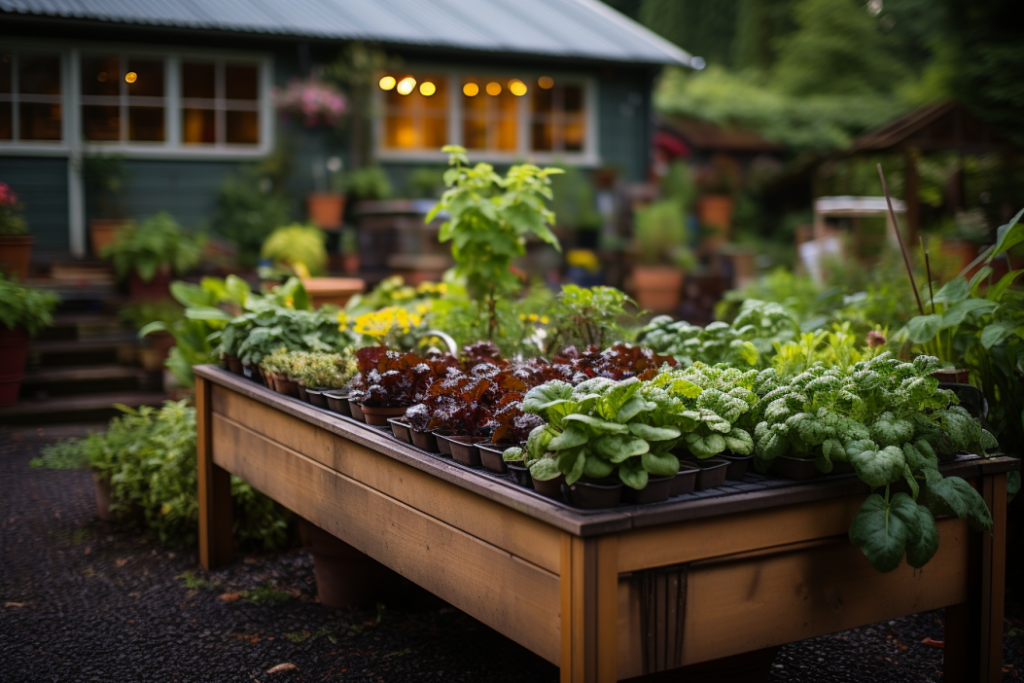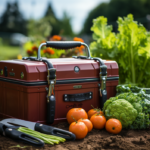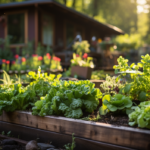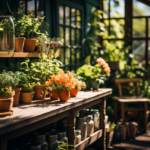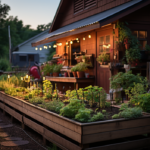Table of Contents
Are you tired of buying produce from the grocery store that has been picked weeks ago? Do you want to create a beautiful and practical kitchen garden that provides fresh vegetables and herbs for your dishes? If so, you’ve come to the right place. The art of garden design can be therapeutic and challenging at the same time. There’s nothing like harvesting the fruits of your labor and incorporating them into a delicious meal. By following some simple guidelines, you can transform your backyard into an oasis of fresh and flavorful ingredients. In this article, we’ll show you how to design a kitchen garden that not only looks incredible but also adds value to your property.
Choosing the Right Location for Your Kitchen Garden
Designing a perfect kitchen garden is not an overnight process. It requires some planning and consideration of several essential aspects, like choosing the right location for your garden. Your garden’s location can significantly impact the growth and success of your plants, so it is crucial to take careful consideration when choosing a spot. In this article, we’ll provide you with valuable insight into choosing the right location for your kitchen garden.
Find a Sunny Spot
The first and foremost thing to consider is finding a sunny spot. Most vegetables and herbs require at least 6 to 8 hours of sunlight each day, so it is essential to find a location with full sun exposure. Look for a spot that receives sunlight throughout the day and doesn’t get shaded by trees or walls.
Check the Soil Quality
The soil quality of the chosen location is the second essential aspect to consider. Vegetables and herbs require well-draining soil with a high level of organic matter. Check the soil quality by taking a soil sample and testing the ph level.
Accessibility
Choosing an accessible location is also crucial. Make sure your garden is located in a place where it is easy to reach for watering and maintenance. Good drainage, level ground and easy access paths would make the maintenance work much easier.
Proximity to Water
Another important aspect to consider is proximity to water. Choose a location near a water source or install a hose connection nearby for easy watering. Adequate watering is important for ensuring the success of your garden, so it is essential to have access to water.
In conclusion, choosing the right location for your kitchen garden is a crucial first step when designing your garden. By considering aspects like sunlight, soil quality, accessibility, and proximity to water, you can ensure the success of your garden and enjoy delicious, healthy fresh produce.
Planning the Layout of Your Garden
Before starting your kitchen garden, it’s essential to determine what you want to grow and how much space you need. Planning the layout of your garden is crucial to ensure that you have enough room for your plants and that they receive adequate sunlight.
Choosing the Right Garden Design
First, decide the type of garden design you want. It could be square foot gardening, raised beds garden, container gardening, or traditional in-ground beds gardening, depending on your preferences and growing needs. Consider incorporating paths and walkways so that you can easily access your plants without stepping on them and causing damage.
Location, Location, Location
The location of your garden is one of the most important decisions you’ll make. You want to choose a spot that gets at least six to eight hours of sunlight each day and that gets enough air circulation to minimize moisture buildup. You also want to pick a location that is easily accessible and visible from the house. If your garden is tucked away and not visible, it can be easy to forget about.
Consider Your Soil Type
The type of soil you have plays an important role in the success of your garden. Before starting, test your soil to determine its pH level and nutrient content. Generally, a pH range of 6.0 to 7.0 is ideal for most plants. If your soil is too acidic or alkaline, you may need to amend it with lime or sulfur. If your soil is nutrient-poor, you may need to add compost or other organic matter to improve fertility.
In conclusion, planning the layout of your garden is essential to the success of your kitchen garden. Take your time and think about the type of garden design you want and your growing needs. Choose a location that gets enough sunlight and air circulation, and amend your soil if needed. By following these tips, you can create a beautiful and functional kitchen garden that provides fresh and flavorful ingredients for your meals.
Selecting and Preparing Your Garden Beds
When creating a kitchen garden, selecting and preparing the right garden beds is a crucial step in ensuring optimal growth for your plants. Here are the essential aspects of selecting and preparing your garden beds:
Choosing the Right Bed Location
The location of your garden bed can affect the quality of your plants. Choose a bed location that receives plenty of sunlight, at least six hours per day, and good drainage to prevent waterlogging or soil erosion. Check your garden bed’s exposure to nearby trees, buildings, and obstacles that can block sunlight and airflow or expose them to harsh winds. Also, ensure that your bed’s location will be convenient for watering, weeding, and harvesting.
Soil Preparation
The quality of your soil determines the quality of your plants. Therefore, it is essential to prepare your garden bed soil by adding organic matter, such as compost, manure, or leaf mold. This organic matter improves soil structure, fertility, and water retention capacity. It also provides essential nutrients to your plants and beneficial microorganisms that enhance their growth.
Bed Depth and Width
The depth and width of your garden bed depend on the types of plants you’ll be growing. Deep beds are suitable for root vegetables, while shallow beds suit herbs and greens. The recommended depth for raised beds is at least six inches, while in-ground beds should be at least 12 inches deep. The width should be easy to reach, tend and harvest without stepping on the soil. A recommended width for a raised bed is between two and four feet.
Tips for Preparing Your Soil
- Test the pH level of your soil to determine its acidity or alkalinity.
- Remove any debris, weeds, or invasive grass before adding soil.
- Loosen the soil by tilling or digging.
- Add organic matter like compost to improve soil fertility, water retention and aeration.
Selecting and preparing your garden beds is a fundamental step towards creating a beautiful and functional kitchen garden. By choosing the right bed location and preparing the soil, you set your gardening endeavor up for success. Remember to also adjust the bed depth and width to suit your plants’ needs.
Choosing the Right Vegetables and Herbs to Include in Your Garden
When it comes to selecting vegetables and herbs to grow in your kitchen garden, it can be a bit overwhelming. After all, there are so many options to choose from! Here are some tips to help you make the best choices for your garden:
Consider Your Cuisine Preferences
Think about the type of dishes you like to cook and base your choices on that. For example, if you love Italian cuisine, then you might focus on growing tomatoes, zucchinis, cucumbers, basil, and oregano. If you enjoy Mexican meals, then you might want to plant cilantro, peppers, tomatoes, onions, and garlic.
Evaluate the Climate
Consider the climate in your area when deciding which vegetables and herbs to grow. Some plants thrive in hot, dry conditions, while others need cooler temperatures and more moisture. Do your research to determine which plants grow best in your region.
Think About Space
When planning your garden, make sure to think about the amount of space you have and how much each type of vegetable or herb will need. Some plants require more room to grow than others, so keep that in mind when deciding which ones to include.
Choose a Mix of Annuals and Perennials
Include both annuals and perennials in your garden. Annuals grow for one season and then die, while perennials come back year after year. This approach allows you to have a mix of different vegetables and herbs growing in your garden at different times of the year.
Prepare Your Soil
Before you start planting, make sure your soil is prepared. Using compost and other organic materials can help improve the quality of your soil and provide the nutrients your plants need to grow healthy and strong.
Take it Slow
Don’t try to plant too much at once; start with a few vegetables and herbs to get the hang of it. As you become more comfortable, you can add more plants to your garden.
Choosing the right vegetables and herbs to grow in your kitchen garden is a crucial aspect of garden design. By considering your cuisine preferences, evaluating the climate, thinking about the space you have, and choosing a mix of annuals and perennials, you can create a garden that provides a bounty of fresh produce and herbs for you to enjoy. Just remember to prepare your soil and take it slow as you start to build your garden, and you’ll be well on your way to success.
Conclusion
Congratulations! You now have the tools to create your own beautiful and functional kitchen garden. With careful planning, soil preparation, and plant selection, you can create an oasis that will provide you fresh produce all season long. From juicy tomatoes to fragrant herbs, there’s nothing like picking your produce and using it in your cooking. Remember to also consider the aesthetics of your garden by incorporating annual flowers, garden ornaments and even garden lighting. Whether you’re an experienced gardener or just starting, you’re sure to enjoy the benefits of a bountiful kitchen garden. So get planting and enjoy the fruits of your labor!

